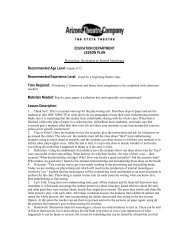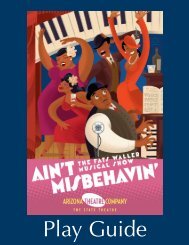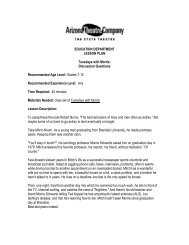Play Guide [1.2MB PDF] - Arizona Theatre Company
Play Guide [1.2MB PDF] - Arizona Theatre Company
Play Guide [1.2MB PDF] - Arizona Theatre Company
You also want an ePaper? Increase the reach of your titles
YUMPU automatically turns print PDFs into web optimized ePapers that Google loves.
- Speaking characters are shown by name followed by what they say. For example:<br />
Jim: How are you feeling now? Better?<br />
Laura: Yes. Yes, thank you.<br />
- There are stage directions (in parenthesis) discussing the character’s emotions, as<br />
well as providing information about staging and blocking.<br />
- Discuss the differences between linear and non-linear narrative. How does<br />
this impact storytelling on stage? How does the narrator function in a non-linear<br />
memory play?<br />
2) Have each student think about a happy memory that he or she remembers very clearly.<br />
Have the students write notes about what was happening, how they were feeling, others<br />
involved, etc. Each student should also list the objects present in the memory, as well as<br />
the ways in which people moved and the actions they took. These specifi c memory pieces<br />
will become props, scenic elements, and blocking in the student’s scene.<br />
3) Next, each student will take his or her memory and create a short scene (2-4 minutes)<br />
following the format of the discussed example from the play.<br />
- Students should try to keep the character limit between 2-4 people to focus the<br />
events (depending on how many students are in the classroom). If their memory<br />
has more than 2-4 people in it, have them pick a specifi c part of the memory to<br />
accommodate the class. Remind them that they can use the non-linear structure and<br />
a narrator to help keep the number of actors low.<br />
4) Once the students have fi nished writing, ask a student to volunteer to have his or her<br />
script read aloud for the class. Ask the class clarifying questions about the script to see if<br />
they understood what happened. Then discuss the characters and relationships they see,<br />
fi nd ways to add to or change it, and make sure there is a beginning, middle, and end.<br />
Staging Activity<br />
1) Once the scripts are written, create groups of 3-5 students (adjusting as needed to fi t<br />
with number of characters in each scene). Have the groups discuss each person’s scene<br />
and choose one scene they would like to perform based on their interest in the scene and<br />
the ability to perform it. In order to help the students choose a scene, as them to consider<br />
the following:<br />
- Character clarity – Who are these characters? Are they active? Do they have clear<br />
objectives within the scene? The clearer the characters, the easier they are to present<br />
and embody.<br />
- Action – Does the scene contain activity for the characters so that they are not<br />
merely sitting around talking? The excitement of the theatre comes from watching<br />
characters on stage do things, rather than talk about them. Although The Glass<br />
Menagerie employs a narrator, it is also still full of action.<br />
Students should use these ideas to help guide their scene choice.<br />
The Glass Menagerie<br />
<strong>Arizona</strong> <strong>Theatre</strong> <strong>Company</strong> <strong>Play</strong> <strong>Guide</strong> 31


![Play Guide [1.2MB PDF] - Arizona Theatre Company](https://img.yumpu.com/11952176/31/500x640/play-guide-12mb-pdf-arizona-theatre-company.jpg)
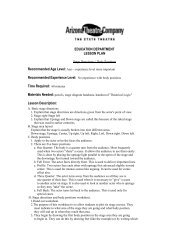



![Play Guide [356k PDF] - Arizona Theatre Company](https://img.yumpu.com/46218320/1/190x245/play-guide-356k-pdf-arizona-theatre-company.jpg?quality=85)
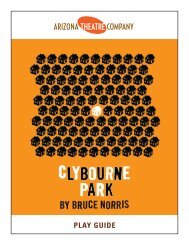
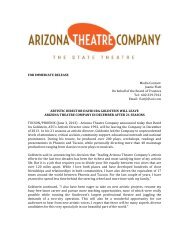
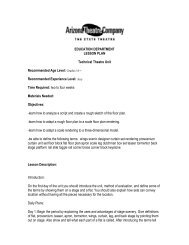
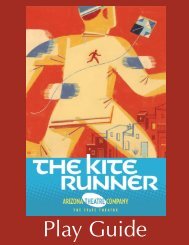

![[title of show] Arizona Theatre Company Play Guide 1](https://img.yumpu.com/24482689/1/190x245/title-of-show-arizona-theatre-company-play-guide-1.jpg?quality=85)
